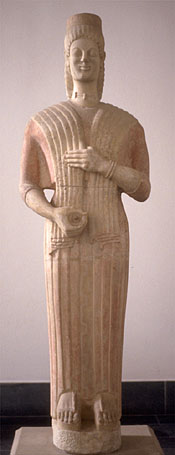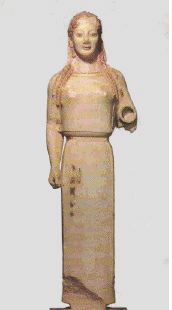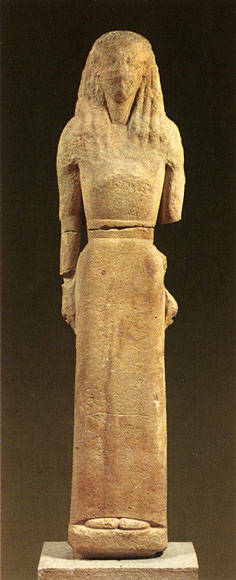Free standing marble statues began to appear near the end of the seventh century. They were “youthful and beautiful” and served as both votive offerings in sanctuaries and also as funeral monuments (Whitley 220). A kore (pl. korai) is a standing Archaic stone statue (typically in marble or limestone) of a draped, unmarried female figure. Usually these statues were life-size. With the development of the korai, Greek sculpture started to become more “monumental” (Whitley 198). Sculptors of korai attempted to realistically represent the human body at rest. They were generally stiff looking, with a rigid stance (often with one foot in front of the other and both feet flat). The face was emotionless, aside from indications of the archaic smile. Sculptors experimented with the positioning of the arms. This was in contrast to the male statues which had arms positioned at the sides of the bodies. The korai were meant to be observed from the front. The model for these forms was thought to have been influenced by Eastern prototypes or possibly from the Daedalic tradition.
The main difference between the female figures and the male figures (pl. kouroi) was that the female figures were fully clothed. At the time it was unacceptable in Ancient Greece to show females in the nude. The drapery of the korai’s garments became important in analyzing the predominant clothing styles for women. Often the clothing of the korai was incised or elaborately painted (although only traces of paint remain on the stone). Many korai were dressed in peplos. The peplos was a garment made from one piece of heavy drapery, usually wool. Under the peplos women generally wore a chiton (a light linen garment). Often an overfold and a shawl accompanied the peplos. This dress style was common to both mainland Greece and Doric areas in the seventh century BCE. The garment covered the body from the neck to the foot and was fastened at the shoulder with a pin.
The peplos was replaced with a sleeved chiton in the sixth century. The sleeved chiton could be worn alone or with a himation draped from the right shoulder to below the left armpit (this clothing style originated in Ionia). The sixth century korai reflected this change in accepted style of dress. The korai became elaborate and highly decorated during this time as the garment showed elements of ornamentation. Remnants of paint found on some korai indicated that the chiton was brightly colored, as the marble had often been painted with red, yellow and blue paints.
 Berlin Kore image from http://www.utexas.edu/courses/introtogreece/lect9/hBerlinGoddess9907080115.jpg
Berlin Kore image from http://www.utexas.edu/courses/introtogreece/lect9/hBerlinGoddess9907080115.jpg
The Berlin Kore was one of the earliest sixth century korai found which demonstrated this change in clothing style. Incredibly well preserved, the Berlin Kore wore a shawl which was draped on top of her sleeved chiton. Her body was adorned with jewelry which included a necklace, earrings and a bracelet and on her head she wore a headdress (called a polos). Due to the unique preservation of this kore (thought to have been wrapped in a sheet of lead) traces of paint have been found on the stone.
 Peplos Kore image from http://www1.hollins.edu/faculty/saloweyca/Athenian%20Woman/Nadia%20Manifold/Portrayal%20of%20Women%20Throughout%20Greece_files/image003.jpg
Peplos Kore image from http://www1.hollins.edu/faculty/saloweyca/Athenian%20Woman/Nadia%20Manifold/Portrayal%20of%20Women%20Throughout%20Greece_files/image003.jpg
The Peplos Kore which dates to 530 BCE was from the Athenian acropolis and was one of the last known korai shown to be wearing the peplos as a form of dress. This statue was constructed from several pieces of marble, as the left arm and hand were missing. There were indications that many details of the Peplos Kore were painted, including her hair, eyes, lips, and eyebrows. She was adorned with metal additions—a wreath, earrings, and a pin, however only the holes as indications of these metal additions remained.
The changes in clothing styles created variations in the korai which could be thought of as more distinguishable than any of the changes made to the kouroi. Regional differences in korai were also more evident. “Korai on the other hand differ in both setting and form: in east Greece, especially at the Samian Heraion, full-figured, ‘cylindrical’ korai are set on low bases, sometimes in groups; on the Athenian Acropolis, korai have a more ‘masculine’ form, and are often placed on top of the votive columns, where they could only be seen from below” (Whitley 220).
From viewing the evolution of korai over time, one can see that a greater understanding of the human anatomy developed and the sculptors developed techniques to more accurately depict human features. As the Archaic period came to an end, the korai became increasingly simplified. Additionally, there was an increase in the volume of the body depicted underneath the garments, as the body became both fuller and rounder.
 Nikandre was the first known kore and she was found at Delos. Image from http://ccwf.cc.utexas.edu/~bruceh/cc307/orient/images/043.jpg
Nikandre was the first known kore and she was found at Delos. Image from http://ccwf.cc.utexas.edu/~bruceh/cc307/orient/images/043.jpg
Works Cited:
Biers, William R. The Archaeology of Greece. Ithaca: Cornell University Press, 1996.
Shanks, Michael. Classical Archaeology of Greece: Experiences of the Discipline. New York: Routledge, 2004.
Whitley, James. The Archaeology of Ancient Greece. New York: Cambridge University Press, 2007.
Posted at Dec 16/2007 10:22PM:
Kuy Yeon Lee: Your project on Kore's been very helpful for preparing for the final... I've always wanted some kind of chronological classification of them. Thank you so much for clear explanations!!
Posted at Dec 17/2007 07:46AM:
Rachel Griffith: Thanks! This is really helpful. It is so easy to lose chronology in history, but this was arranged so that a clear progression could be seen.
